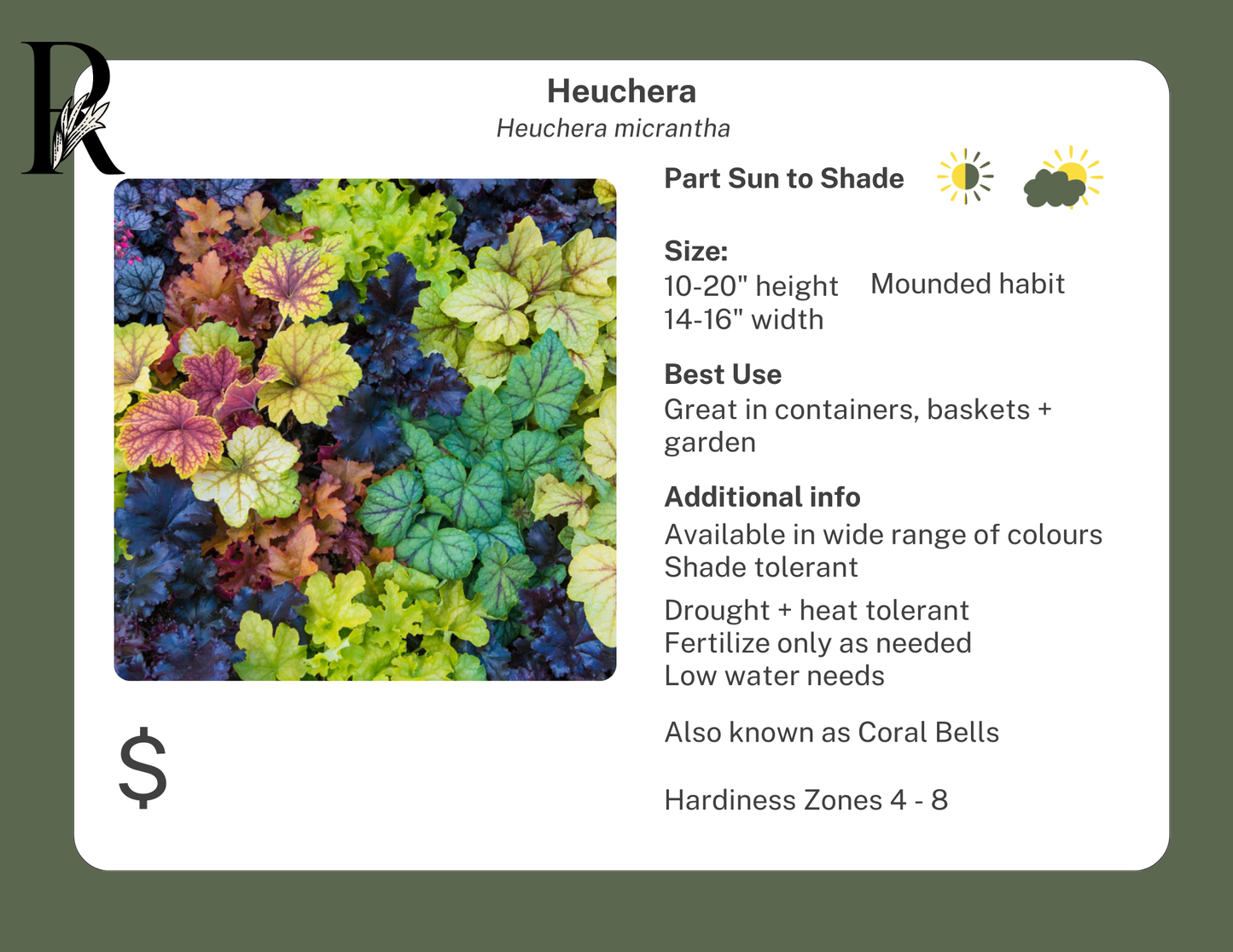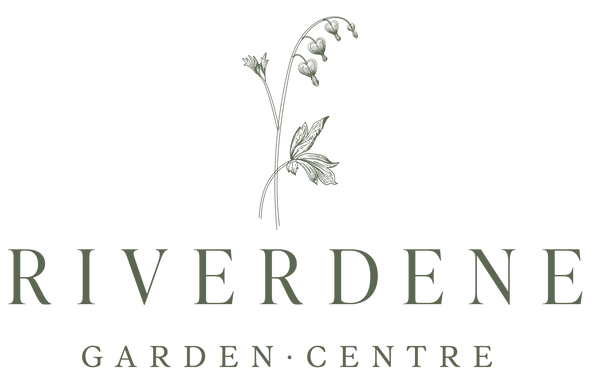Riverdene Garden Centre
Heuchera
Heuchera
Couldn't load pickup availability
AKA Coral Bells
Heuchera, commonly known as coral bells, is a hardy, low-maintenance perennial prized for its colorful foliage and delicate flowers. It thrives in shade to partial sun and adds year-round interest with its mounded, evergreen leaves in shades of green, purple, silver, red, and bronze. The small, bell-shaped flowers rise above the foliage on slender stems in late spring to summer, attracting pollinators like bees and hummingbirds. Ideal for borders, containers, and ground cover, heuchera is an excellent choice for gardens in Southwest Saskatchewan.
Planting & Growing Conditions
- Hardiness Zone: 3-9 (varies by variety; some are more cold-hardy than others)
- Mature Size: 8-18 inches tall, 12-24 inches wide (compact, mounding growth habit)
- Growth Rate: Moderate to fast
-
Sunlight Needs:
- Partial shade to full shade (best for vibrant foliage and longevity)
- Tolerates morning sun and afternoon shade in hot climates
- Some varieties, especially those with lighter-colored leaves (yellow, lime green, orange), can tolerate more sun
-
Soil Requirements:
- Prefers rich, well-drained, loamy soil
- Neutral to slightly acidic soil (pH 6.0-7.0)
- Avoid heavy clay or overly wet conditions, as heuchera dislikes standing water
- Spacing: 12-18 inches apart for optimal air circulation
Watering & Maintenance
-
Young Plants (First Year):
- Water deeply 2-3 times per week to help roots establish
-
Established Plants:
- Drought-tolerant but prefers regular watering during dry spells
- Water once a week in moderate weather; increase during hot, dry periods
-
Mulching:
- Apply a 1-2 inch layer of mulch around the base to retain moisture, prevent weeds, and protect roots from temperature fluctuations
- Avoid mulching directly over the crown to prevent rot
Fertilizing
- First Year: No fertilizer needed—focus on root establishment
-
Mature Plants:
- Apply a slow-release balanced fertilizer (e.g., 10-10-10) in early spring
- Use compost or organic mulch for added nutrients
- Avoid excessive nitrogen, as it can encourage leggy growth
Pruning & Maintenance
- Best Time to Prune: Early spring, before new growth starts
-
How to Prune:
- Remove dead or damaged leaves throughout the growing season
- Trim spent flower stems after blooming to maintain a tidy appearance
- Every 3-5 years, divide and replant heuchera to prevent overcrowding and rejuvenate growth
Flowers, Foliage & Seasonal Interest
- Bloom Time: Late spring to early summer (May-July)
-
Flower Color:
- Tiny, bell-shaped flowers in white, pink, or red, rising above foliage on wiry stems
- Long-lasting and attracts pollinators
-
Foliage Colors & Characteristics:
- Available in shades of green, purple, red, bronze, silver, and chartreuse
- Some varieties have ruffled, lobed, or veined leaves
- Semi-evergreen in mild climates (leaves may persist in winter but may need refreshing in spring)
-
Winter Interest:
- Retains some foliage in milder winters
- May need light pruning in early spring to remove winter-damaged leaves
Pest & Disease Management
Resistant to: Deer, rabbits, and most common pests
Common Pests:
-
Vine Weevils – Can chew on roots and leaves
- Solution: Use beneficial nematodes or insecticidal soap
-
Aphids – May feed on new growth
- Solution: Spray with insecticidal soap or introduce ladybugs
Common Diseases:
-
Crown Rot & Root Rot – Occurs in waterlogged soil
- Solution: Ensure well-draining soil and avoid overwatering
-
Powdery Mildew – White fungal coating on leaves in humid conditions
- Solution: Improve airflow and apply an organic fungicide if needed
Winter Protection
- Cold-Hardy in Zones 3-9, but may require extra mulch protection in colder climates
-
Mulching:
- Apply 2-3 inches of mulch in late fall to protect roots from freeze-thaw cycles
-
Snow Cover:
- Natural snow cover acts as insulation, protecting roots from extreme cold
Landscape Uses
Great for shade gardens and woodland settings
Perfect for borders, edging, and mass plantings
Works well in containers and hanging baskets
Attracts pollinators like bees and hummingbirds
Pairs well with ferns, hostas, and ornamental grasses
Additional Notes:
- Lifespan: 5+ years with proper care
- Dividing: Every 3-5 years to maintain vigor
- Companion Plants: Ferns, hostas, astilbes, bleeding hearts, and coral bells of different colors
Share


